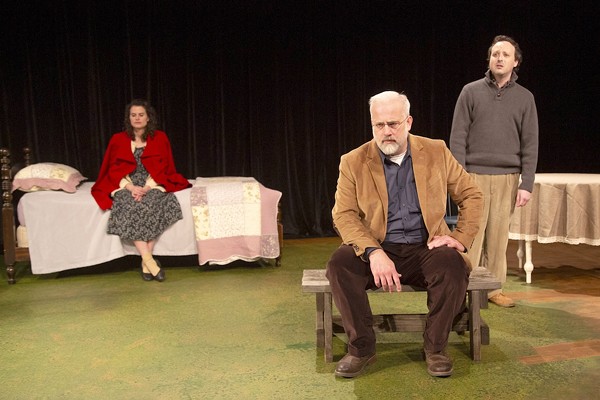Entertainment
Molly Sweeney Captivates With a Touching, Bittersweet Tale

Too often, the ability to change a situation captures our imagination and takes over rational thought before we’ve had the time to consider whether that change is for the best. Or if that change is something we actually want. Such is the case in Molly Sweeney by Irish playwright Brian Friel. Albion Theatre, which primarily produces plays from the UK, captures this logical and emotional conflict in an effectively compelling production directed by company founder Robert Ashton.Molly Sweeney has been blind since she was 10 months old, yet she manages to navigate her world with confidence and relative ease. Naturally, there are longings, questions and a multitude of challenges as she moves through the sighted world, but there’s a sense of comfort and wellbeing in her life. Approaching middle age, she is relatively happy with her marriage to Frank, her friendships and her occupation as a massage therapist. Frank, however, is a wannabe hero always looking for his next project. This compulsion leads to an appointment with Mr. Rice, a noted eye surgeon who’s recently taken residence at the local hospital. Intrigued by Molly’s condition and the possibility of restoring her vision, the doctor agrees to examine and then operate on Molly.
While the procedures do not fully restore her sight, they are nonetheless a success — at least initially. As the story progresses, the doctor battles his affection for the bottle while dreaming of redemption among his peers. Frank is supportive, but begins to look for a new opportunity to be the hero far away from County Donegal. Molly struggles to adjust, finding comfort in retreat and the warmth of memory and darkness.
Maggie Wininger is captivating and convincing as Molly, and her portrayal of blindness is remarkable in its believability and lack of prosthetics or dark glasses. There’s an easy charm to her manner and a certainty of movement that emphasizes Molly’s misgivings about the sighted experience. Wininger fully embraces the poetic cadence of Friel’s script to the point that the audience often sees the world as Molly does, particularly through descriptions of the plants and flowers she adores and recollections of her courtship and early days with Frank. While Rice and Frank often proclaim that she “has nothing to lose,” Molly convincingly questions what it is she has to gain.
Paul Gutting is sympathetic as a surgeon with blunted but not abandoned ambition, his senses dulled through betrayal and addiction. CJ Langdon easily captures Frank’s delusion of heroism, his constant need for a project to conquer and the way he expresses that need though controlling behaviors and obsessive but shallow research. Frank’s an ebullient, enthusiastic fellow, full of facts and unfounded certainty but unable to comprehend the important distinction between seeing and understanding.
The intimate and deeply personal Molly Sweeney offers audiences a glimpse into the psyche of a blind person as well as the opportunity to reflect on the benefits and drawbacks of our own abilities and challenges. Albion Theatre’s production and Wininger’s deeply connected performance ensure that this lovely but tragic play lingers long after the final bow.
Subscribe to Riverfront Times newsletters.
Follow us: Apple News | Google News | NewsBreak | Reddit | Instagram | Facebook | Twitter | Or sign up for our RSS Feed
Entertainment
Back to the Future, Meet Me in St. Louis to Play on Art Hill This Summer

Saint Louis Art Museum will go back to the past this summer — with two fan favorites making encore presentations at its beloved Art Hill film series.Those films, Back to the Future and Meet Me in St. Louis, were voted on by fans. The sci-fi comedy classic will be screened on July 12 and the Judy Garland musical on July 19.Both programs begin at 6 p.m. with food trucks curated by Sauce Magazine. Parking is free and so is admission to the films, with seating on a first-come, first-served basis. People are invited to pack their own picnics if they prefer. The films begin each night at 9 p.m. Keep an eye on Saint Louis Art Museum’s Facebook, Instagram and slam.org for details in the case of inclement weather. But if the weather cooperates, you’ll want to plan to meet your fellow film fans in St. Louis — and make that the Saint Louis Art Museum while you’re at it. Subscribe to Riverfront Times newsletters.Follow us: Apple News | Google News | NewsBreak | Reddit | Instagram | Facebook | Twitter | Or sign up for our RSS Feed
Entertainment
The Trees I’ve Loved — and Lost

My neighbor told me she plans to cut down her tree and my heart stopped. The tree in question is an enormous Japanese maple that covers her yard and spills into my own. In the spring, it splashes a rich red across my bathroom window, and the tree has become such an integral part of my home that I can barely imagine life without it. Besides, I am still smarting from the loss of the mimosa tree at the end of my block. The silky, pink blooms sprung to life each May and stuck around until August, perfectly complementing the mint green paint on the adjacent garage. It was cut down without fanfare last year. I imagine my neighbors enjoy the unobstructed space for their patio table and lawn chairs, but when I look at their yard, I only see what’s missing.
The prospect of losing the maple with Arbor Day just around the corner flooded my mind with memories of other trees that have touched my life. I grew up in a pecan-orchard-turned-subdivision in Arlington, Texas, where the tree branches reached across the road to form a green tunnel that shaded your car as you weaved through the neighborhood. Visitors commented, but I never noticed. I wasn’t what you would call “outdoorsy.” I was a suburban girl, more inclined towards a trip to the mall than a walk in the park. What I did notice were the grocery bags full of pecans that my family harvested each year from the tree in our front yard alone. My dad even had a contraption for picking up the nuts without bending over—imagine a slinky on a broomstick and you get the picture.
Sometimes, I was taken outdoors against my will. On a camping trip when I was eight, my friend’s mom invited us to play a game. She took us into a field, blindfolded us and introduced each of us to a tree that we were to learn by touch. She then brought us back to the field, restored our sight and let us loose to find our tree. For the rest of the trip, I smiled each time I saw “my” tree and brought home a sketchbook filled with its portraits.
Growing up didn’t do much for my love of nature, but I did have a favorite tree at my San Antonio university. The campus was known for its sprawling live oaks donated by the Sears, Roebuck and Company in 1960 and its Champion Mexican sycamore that stood 70 feet tall. The tree I loved was not so fancy. I don’t even know what kind it was, only that it sat in a concrete grid behind the dining hall among eight other nearly identical trees. But this one was so perfectly symmetrical that it delighted the eye and stood out among its peers. So devoted was I to this tree, I did a photo shoot with it when I graduated, back when that required a real camera and actual film.
In Southern California, I met the jacaranda. The bright lavender blooms line the streets of Los Angeles and Orange County in the spring and the fall. They always reminded me of that Robin Williams movie What Dreams May Come, the sad one in which he ventures into his wife’s paintings after her suicide. Subject matter aside, walking among jacarandas feels like walking into a painting, and when its flowers fall it looks like purple rain.
I once attended a funeral for a tree in San Francisco. I never knew the tree, but my neighbors did and were devastated by the loss. My husband mourned a different tree. Perhaps you remember it? The Keebler Elf Tree in Tower Grove Park had a burly trunk with a tiny door-like opening that beckoned to those who believe in magic. Its branches dipped low to the ground and swept up again, inviting intrepid readers to perch and lose themselves in other worlds. Once it was marked for destruction, children’s drawings appeared like talismans on the fence that surrounded it. All that love couldn’t save the tree. Its legacy lives on, though, commemorated on Schlafly beer cans. Like so many Saint Louisans, my husband still misses that tree. He says “losing a tree is like losing a friend.”
Today is Arbor Day, a day to celebrate and plant trees. The first U.S. Arbor Day took place in Lincoln, Nebraska, in 1872. Citizens planted over one million trees. If we attempted that feat in St. Louis today, where would we put them? Would we confine the trees to our parks and the Missouri Botanical Garden? Or would we use them to shade our parking lots, schools and homes and give some life to the luxury apartments popping up like weeds with no landscaping in sight? What trees have made your life better and what trees are worth fighting for?
I can’t stop thinking about the Japanese maple. Perhaps I pay closer attention knowing its days are numbered, but I hate to think this is the last season I will see sun dappling through its leaves. In my neighbor’s defense, the tree takes up her entire yard. In the tree’s defense, it is so, so beautiful. I guess I’m a nature lover after all.
The RFT welcomes short essays on topics of local interest. Contact [email protected] if you’ve got something to say.
Subscribe to Riverfront Times newsletters.Follow us: Apple News | Google News | NewsBreak | Reddit | Instagram | Facebook | Twitter | Or sign up for our RSS Feed
Entertainment
Esquire Names St. Louis’ 21c Museum Hotel One of 2024’s Best New Hotels

St. Louis’ 21c Museum Hotel was named one of the “41 Best New Hotels in North America and Europe 2024” by Esquire last month.
21c Museum Hotel (1528 Locust Street) opened last year in Downtown West in the city’s old YMCA building. While nodding to the building’s past by keeping the gym’s flooring, a renovated iteration of the YMCA’s lap pool (now the Locust Street Athletic and Swim Club), keeping the wood paneling and more, the hotel offers luxurious rooms, art galleries, a top-notch bar and incredible, immersive art throughout.
In its article, Esquire says, “It changes the way you think about art, hotels, and, hell, St. Louis itself.”
click to enlarge 21c Museum Hotel St. Louis The second floor hosts a large gallery space that debuted with a group exhibition, Revival: Digging Into Yesterday, Planting Tomorrow, that will be on display through June of next year.
The item also talks about the restored basketball court art gallery, which features artists Kehinde Wiley, Esiri Erheriene-Essi and Simone Elizabeth Saunders, as well as 21c’s free 24/7 museum, the restaurant Idol Wolf and the way history shines throughout the hotel. “Touches throughout nod to St. Louis’s former glory, including a magnificent Renaissance Revival pool, while the life that thrums through the lobby bar points to the city’s promising future,” the writers say.All that and one of the second-least expensive pricepoint on the list? We’ll take more press like this, please!
For more information on the 21c Museum Hotel read the RFT’s “21c Museum Hotel Dazzles in St. Louis’ Old Downtown YMCA Building” or visit 21c’s website.
Email the author at [email protected]
Subscribe to Riverfront Times newsletters.Follow us: Apple News | Google News | NewsBreak | Reddit | Instagram | Facebook | Twitter | Or sign up for our RSS Feed
-

 Entertainment1 year ago
Entertainment1 year agoSt.Louis Man Sounds Just Like Whitley Hewsten, Plans on Performing At The Shayfitz Arena.
-

 Business1 year ago
Business1 year agoWe Live Here Auténtico! | The Hispanic Chamber | Community and Connection Central
-
Board Bills1 year ago
2022-2023 Board Bill 189 — Public Works and Improvement Program at the Airport
-

 Local News1 year ago
Local News1 year agoVIDEO: St. Louis Visitor Has Meltdown on TikTok Over Gunshots
-

 News1 year ago
News1 year agoTed Lasso-inspired pop-up bar now open in St. Louis
-

 Board Bills1 year ago
Board Bills1 year ago2022-2023 Board Bill 165 — Jefferson Arms Community Improvement District
-
Board Bills1 year ago
2022-2023 Board Bill 183 — Amending Ordinance Number 62885 known as the Capital Improvements Sales Tax
-
Board Bills1 year ago
2022-2023 Board Bill 180 — Right to Counsel for Tenants Facing Eviction





